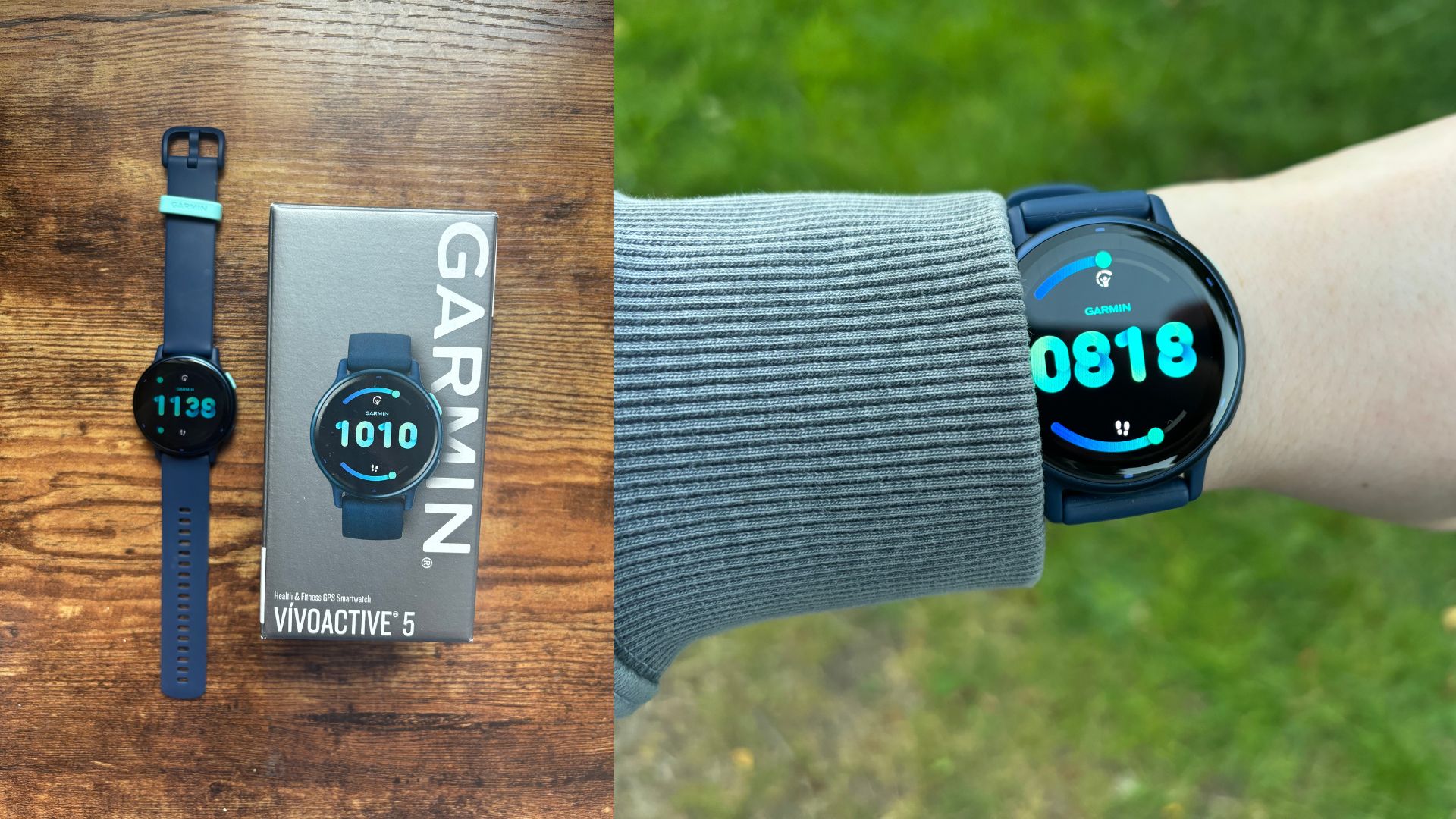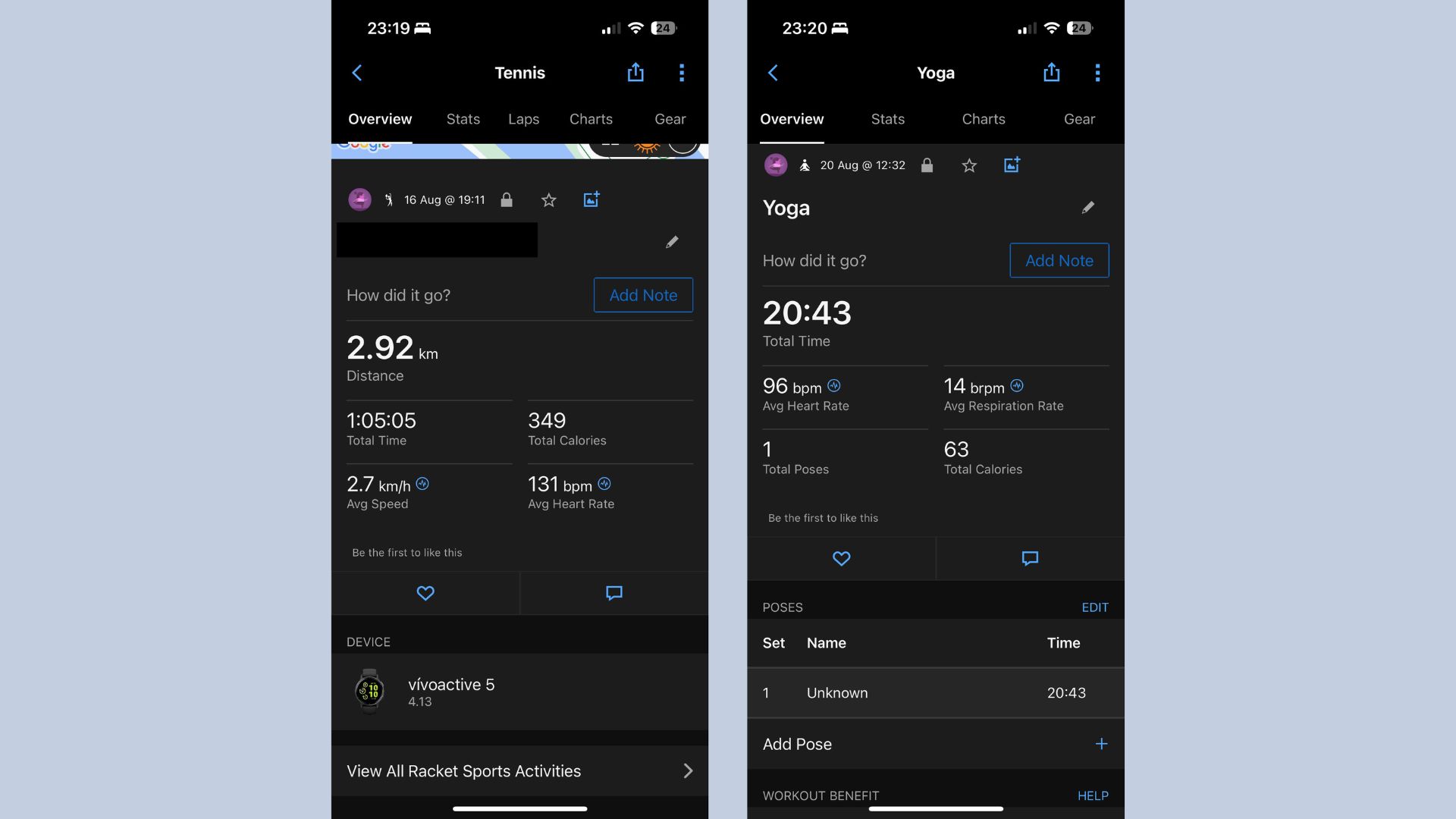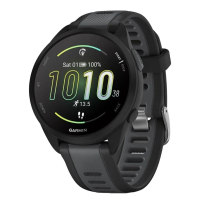Garmin Vivoactive 5 review: 'The perfect entry-level tracker for improving my fitness'
Health Writer Ciara McGinley spent two weeks reviewing the Garmin Vivoactive 5. She reveals why it's so good - plus, how it compares to the Venu 3

A fantastic entry-level watch for those new to fitness tracking and dedicated to learning more about their overall physical health.
-
+
Great for everyday health and fitness tracking
-
+
Smaller and sleeker than previous models
-
+
Detailed fitness and sleep insights
-
+
Advanced health data
-
-
Doesn’t include all running features
-
-
No floor counter/barometric altimeter
Why you can trust Woman & Home

Grace Walsh
The Garmin Vivoactive 5 might not be the brand's newest fitness tracker - but it's the one we can't stop talking about. With a versatile set-up, sleek design, and seamless lifestyle features, it's the perfect all-rounder for those who want a little bit of everything.
Whether you’re new to the world of fitness wearables or looking to upgrade to one of the best fitness trackers, it’s worth checking out Garmin’s Vivoactive 5. The sleek and lightweight fitness tracker was created to help you get to know the real you, providing insights into your health, fitness and sleep so you can set goals and track your progress at the touch of a screen.
If you're wondering 'which Garmin should I buy', you're in the right place. I’ve tried many fitness trackers and smartwatches over the years, from Garmin wearables to rings for fitness tracking, so I was excited to put the Vivoactive 5 to the test to see how it weighed up to some of the more expensive devices on the market.
Garmin Vivoactive 5 review
Specifications
- RRP: £259
- Size: 42.2 x 42.2 x 11.1 mm
- Weight: 26g
- Material: Silicone & Anodised aluminium
- In-built GPS: Yes
- Battery life: up to 11 days
- Waterproof: up to 50m

The Vivoactive 5 is an excellent choice for anyone looking to make improvements in their health and fitness routine. You'll find this watch available in black, white, purple and navy direct from Garmin as well as at retailers like Amazon, Decathlon, and Argos.
Garmin Vivoactive 5: An overview
The Garmin Vivoactive 5 is an upgrade to the Vivoactive 4 and was released in September last year. This new edition is smaller than the last, creating a more streamlined look on the wrist. It has a brighter display, a longer battery life, upgrade heart sensors, advanced health tracking abilities for sleep and stress, and 30+ sports modes. Perhaps a better way to put it would be - what doesn't this watch have?
What’s more, compared to other Garmin devices such as the Garmin Venu 3 and devices from the Forerunner range, it comes at a more budget-friendly price with an RRP of £259.99 - and perhaps even cheaper if you can find a Garmin sale.
I tested the Garmin Vivoactive 5 for two weeks across multiple workouts, nights of sleep, and daily life.
Design of the Garmin Vivoactive 5
Comfortable and lightweight, the Vivoactive 5 has had a design update. It features a new silicone strap and it’s smaller than its predecessor, with a 42mm round watch face and a brighter screen. Unlike some of Garmin’s other models made from stainless steel, the Vivoactive 5 watch is made from aluminium, making it lighter - a positive for daily life. This may mean it's not as durable as other devices but it does feature the same sturdy and scratch-resistant glass as other watches, so my hopes are high.
I’ve always found Garmin watches easy to use, even for those who don’t consider themselves tech-savvy. It could be easier to swipe or click through the on-screen features and access your stats with the touch-screen interface and two buttons on the side of the device. These come as standard across most Garmin watches and I like the dual navigation as it gives you options for when you're on the move.
However, there aren't as many colourways for the Vivoactive 5 as for other Garmin watches. I opted for the navy tracker for testing, which was a nice change from my usual go-to black watches. You can also pick up the Garmin Vivoactive 5 in black, lilac or white. If colour and design are particularly important to you, it's worth checking out the Apple Watch Series 9 or the Fitbit Versa 4, as these come with more options.

The Vivoactive 5 has a bright display and comes in several colours, including navy.
Fitness tracking with the Garmin Vivoactive 5
When it comes to fitness tracking, Garmin devices are top of the range - and the Vivoactive 5 is no exception. I’m always impressed with Garmin’s ability to accurately track my activity and daily movement, from my humble attempts at playing tennis to my indoor rowing workouts, yoga sessions and evening walks. After my indoor rowing workout, I compared the Garmin stats with those on my rowing machine and was pleasantly surprised to see they were almost identical. Big points for accuracy!
Thanks to the update to the Vivoactive 5 model, similar to the latest Venu 3, there are now 30+ preloaded workout modes on the watch. This meant I could easily find my activity and start my workout at the touch of a button. For wheelchair users, the Vivoactive 5 can track daily pushes and offer built-in workouts designed for you, which is a new feature.
Once you start a workout, you'll be able to see all your vital stats on your watch screen. For example, if you're going out on a run, you'll be able to see your distance, pace, heart rate zone, and a timer for how long you've been out. Start a strength training workout and the watch can count your reps - although, you will have to tap your wrist to start a new set.
When the workout is done, you'll find all the detailed insights you need in the free Garmin Connect app. Unlike many fitness trackers, such as the Oura Ring and Whoop 2.0, you don't need an additional subscription to use the Garmin app and get insights, which is always positive. This is standard across all Garmin devices though, so the Vivoactive 5 isn't doing anything new in this way.

The Garmin Vivoactive 5 has over 30 workout profiles to choose from, everything from running and tennis to yoga and Pilates.
Where the Garmin Vivoactive 5 differs from other Garmin devices is some of the sensors. The device is missing a barometric altimeter - which is essentially a flight counter - so the Vivoactive 5 doesn't count how many 'flights' of stairs you do every day. It's unclear why the brand has removed this feature, especially as it's promoted as a general fitness smartwatch rather than a specific sports watch where this metric wouldn't be so useful.
If you’re a keen runner and detailed running stats are important to you, it may be worth looking at one of Garmin’s Forerunner devices instead. While the Vivoactive 5 has accurate GPS data and tracking features for indoor and outdoor runs, it doesn’t offer the same detailed information that other Garmin devices in the Forerunner range do - for example, vertical oscillation and stride length. If you're just a regular runner or looking to run more, I don't think this should put you off as these aren't essential data points.
In general, if your goal is to increase your daily activity and monitor your workouts, then the Vivoactive 5 is a great place to start. Set daily step goals, join activity challenges or use the Garmin Coach feature to help you on your journey to a 5k, 10k or half marathon.

Each sports mode on the Garmin Vivoactive 5 offers different exercise-specific insights, like number of strokes in a rowing workout.
Sleep tracking with the Garmin Vivoactive 5
I’m always intrigued to learn more about my sleep, how to sleep better, and how to recover better post-workout, so accurate and detailed sleep analysis is a key feature I look for in any smartwatch or fitness tracker I review.
I’ve previously raved about the sleep-tracking abilities of the Garmin Venu 3, impressed that it weighed up against my beloved Oura Ring - and I have to say the Vivoactive 5 is equally impressive.
It tracks the usual metrics including sleep duration, resting heart rate, breathing rate, and sleep stages to give you an overall sleep score. My favourite feature, however, is the Sleep Coach which offers an insight into how much sleep I may need each night and if I need to add any additional Zzz’s for my baseline to recover.
The effective guided meditations and breathwork practices on the watch face can help you to relax at night and fall asleep easier and the insights provided by the Sleep Coach can tell you if you’re meeting your sleep needs based on your activity and recovery. In the future, I’d love to see Garmin add more sleep support in the app with more resources for better sleep, such as explanations of sleep stages and their importance, and sleep hygiene tips.

Ciara McGinley tested the Garmin Vivoactive 5 through several nights of sleep, recording her sleep duration, stages, and the quality of her sleep.
Health tracking with the Garmin Vivoactive 5
Like most other smartwatches and fitness trackers available today, the Garmin Vivoactive 5 tracks more than just activity, workouts and sleep. It also comes with impressive health monitoring sensors that can help give you a greater picture of your overall health and track your progress as you work towards your goals.
With enhanced health tracking abilities, the Vivoactive 5 can accurately monitor everything from HRV status to respiration rate, blood oxygen saturation, and even your menstrual cycle. I love the Fitness Age feature, which estimates how fit you are compared to your actual age and offers recommendations on how to use this metric to improve your overall health and reach your target age with activity suggestions.
Similar to other fitness trackers, the Garmin Vivoactive 5 has a readiness score called the Body Battery which monitors your energy levels throughout the day. The Vivoactive 5 uses HRV to monitor your stress levels too, giving you an insight into how much time you spend in a stressed state. I found the on-watch guided meditation and breathwork tracks really helpful. It made it easier than ever to take a few minutes to relax at my desk during busy work days. You can also set Relax Reminders that will alert you when your stress is high and encourage you to take a moment to yourself.
Is the Garmin Vivoactive 5 worth buying?
Like any fitness tracker, it depends on what you’re looking for. The Garmin Vivoactive 5 is a great entry-level watch for those new to fitness tracking and dedicated to learning more about their overall physical health with a view to working towards certain fitness goals. I can't fault this device for accurate stats and useful insights into my workouts, daily life, and sleep. It's also so easy to use, which is a big plus.
Though there have been updates to both the design and technology, if you already own the Vivoactive 4 and are happy with how it supports you on your journey to a healthier you, it may not be worth the upgrade as the two devices are fairly similar.
While the Vivoactive 5 is cheaper than the Venu 3 or the Forerunner range, for example, it’s still an investment with an RRP of £259.99 and comes out about the same as one of the newest Apple Watches. If the money's in your budget then I believe it's worth the investment - but if not, other similar options are available. For example, I can also recommend weighing up Garmin vs Fitbit with the Fitbit Charge 6. This device has many of the same features as the Garmin Vivoactive 5 and retails at under £150.
FAQs
Is the Garmin Vivoactive 5 waterproof?
No, the Garmin Vivoactive 5 is not considered completely "waterproof" but it can withstand pressure up to 50m. This makes it fine to wear through water-adjacent activities where you might get splashed - like paddle boarding or kayaking - as well as while swimming, diving into the water, casual snorkeling, and in the shower.
Unless you're diving underwater or scuba diving, you should be fine to take your Garmin Vivoactive 5 along with you. However, read the instructions just to be sure.
Garmin Vivoactive 5 vs Venu 3
I've mentioned the Garmin Venu 3 a few times in my review. As one of the newest Garmin watches that's designed as a general fitness tracker like the Vivoactive 5, it's a worthy comparison. However, the first point worth noting is that the Venu 3 is significantly more expensive than the Vivoactive - almost £200 more (£449 vs £259.99 ) so it's worth considering this before anything else.
Garmin Venu 3: £449 at Amazon
The Garmin Venu 3 is a premium fitness tracker with a premium price tag. Though it has a lot to offer to cyclists and those looking to bridge the gap between a lifestyle watch and fitness tracker, it does offer many of the same features as the Vivoactive 5.
Secondly, the Venu 3 is made from steel rather than the aluminium material of the Vivoactive 5. In testing both, I didn't notice too much of a difference in daily life but the steel is more scratch-resistant than the aluminium and will be able to bear the brunt of more physical activity. So if you're a trail runner, hiker, or cyclist and tend to bang your watch around a bit, the Venu 3 may be a better option.
Equally, if you are a cyclist, you may be better off with the Garmin Venu 3 as the Vivoactive 5 lacks some connectivity features. For example, the Vivoactive 5 can't connect to indoor cycling trainers for programs like Zwift, power meters, cadence, or speed sensors.
While there are differences in battery life between the two - with the Venu 3 (45mm) lasting for 14 days and the Vivoactive 5 lasting for 11 days - the last big difference is in the lifestyle features. The Venu 3 has a speaker and a microphone so you can receive and make calls on your wrist provided you have a Bluetooth connection to your phone. You can also play music out loud through your watch, should you want to. The Vivoactive 5 only allows you to stream music through your headphones.
Winner: Vivoactive 5. Though it may lack some of the Venu 3's features and hardware qualities, the Vivoactive 5 contains all the essentials of the Venu 3 at more than half the price. Unless you're a super keen cyclist, I reckon the Vivoactive 5 will be just perfect.
Garmin Forerunner vs Garmin Vivoactive: Which one should I buy?
Comparing the Forerunner to the Vivoactive range is a little different as these two watches have quite different purposes. For one, the Forerunner range is specifically designed for running. That means it's set up to help those of "all levels and abilities" to run so these watches prioritise runner-friendly metrics over general health and fitness tracking ones. For example, on the home screen, you'll be able to see how many kilometres (or miles, that's down to your preference) you've run so far that week.
Garmin Forerunner 165: £231 at Amazon
The Garmin Forerunner 165 is available in two colours. It offers 11 days of battery life, much like the Vivoactive 5, and has more than 25 built-in workout profiles - including different types of running and other cardio activities like cycling and HIIT.
The Forerunner range does, however, come with a barometric altimeter so you can count the number of 'flights' you climb in a day. While I wouldn't say this is a big game changer (unless that's the metric by which you're tracking your fitness), it's something to consider.
In many other ways, it's very similar to the Garmin Vivoactive range - including in the design. Taking the Forerunner 165 as an example, both devices have brightly lit screens with touchscreen interfaces and three buttons down the side for navigation, though the Forerunner is set into polymer rather than aluminium.
Sign up for the woman&home newsletter
Sign up to our free daily email for the latest royal and entertainment news, interesting opinion, expert advice on styling and beauty trends, and no-nonsense guides to the health and wellness questions you want answered.
Ciara McGinley is a meditation practitioner and health journalist. She qualified as a meditation teacher with the British School of Meditation in 2020 and is the founder of Finding Quiet, a series of classes, workshops and retreats that combine meditation practices and mindfulness techniques to make mindful living realistic in an always-switched-on modern world. She is all about bettering that mind-body connection but believes wellness looks different to everyone.
Ciara is also the former Health Channel Editor at woman&home and has covered all things health and wellbeing for years, from fitness to sleep to relationships.
- Grace WalshHealth Channel Editor
-
 Ruth Langsford just gave us the green light to wear two watches - one for fitness, one for fashion
Ruth Langsford just gave us the green light to wear two watches - one for fitness, one for fashionIt might seem like you have to take a 'one or the other' approach, but this doesn’t have to be the case.
By Emma Shacklock Published
-
 Bye skinny jeans, hello palazzo trousers - Meghan Markle nails New York spring style with her ultra-wide leg look
Bye skinny jeans, hello palazzo trousers - Meghan Markle nails New York spring style with her ultra-wide leg lookJeans will never fully be replaced in my wardrobe but I’ve been finding myself drawn to wearing trousers more and more recently.
By Emma Shacklock Published
-
 Dr Amir Khan reveals the 5 'sneaky' bad habits that may be damaging your health without you realising
Dr Amir Khan reveals the 5 'sneaky' bad habits that may be damaging your health without you realisingThe doctor took to Instagram to discuss the unhealthy habits to break for better work-life balance, sleep, and wellbeing
By Kat Storr Published

